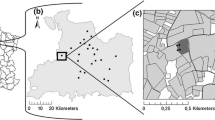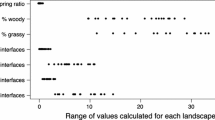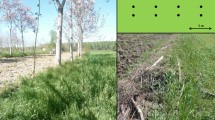Abstract
Context
Agroecosystems are dynamic, with yearly changing proportions of crops. Explicit consideration of this temporal heterogeneity is required to decipher population and community patterns but remains poorly studied.
Objectives
We evaluated the impact on the activity-density of two dominant carabid species (Poecilus cupreus and Anchomenus dorsalis) of (1) local crop, current year landscape composition, and their interaction, and (2) inter-annual changes in landscape composition due to crop rotations.
Methods
Carabids were sampled using pitfall-traps in 188 fields of winter cereals and oilseed rape in three agricultural areas of western France contrasting in their spatial heterogeneity. We summarized landscape composition in the current and previous years in a multi-scale perspective, using buffers of increasing size around sampling locations.
Results
Both species were more abundant in oilseed rape, and in landscapes with a higher proportion of oilseed rape in the previous year. P. cupreus abundance was negatively influenced by oilseed rape proportion in the current year landscape in winter cereals and positively by winter cereal proportion in oilseed rape. A. dorsalis was globally impacted at finer scales than P. cupreus.
Conclusions
Resource concentration and dilution-concentration processes jointly appear to cause transient dynamics of population abundance and distribution among habitat patches. Inter-patch movements across years appear to be key drivers of carabids’ survival and distribution, in response to crop rotation. Therefore, the explicit consideration of the spatiotemporal dynamics of landscape composition can allow future studies to better evidence ecological processes behind observed species patterns and help developing new management strategies.




Similar content being viewed by others
References
Alignier A, Raymond L, Deconchat M, Menozzi P, Monteil C, Sarthou J-P, Vialatte A, Ouin A (2014) The effect of semi-natural habitats on aphids and their natural enemies across spatial and temporal scales. Biol Control 77:76–82
Aviron S, Burel F, Baudry J, Schermann N (2005) Carabid assemblages in agricultural landscapes: impacts of habitat features, landscape context at different spatial scales and farming intensity. Agric Ecosyst Environ 108:205–217
Barton K (2013) MuMIn: multi-model inference, R package version 1.9.0
Bates D, Maechler M (2013) lme4: linear mixed-effects models using S4 classes. R package version 0.999999-0. http://CRAN.R-project.org/package=lme4
Bertrand C, Baudry J, Burel F (2016a) Seasonal variation in the effect of landscape structure on ground-dwelling arthropods and biological control potential. Basic Appl Ecol 17:678–687
Bertrand C, Burel F, Baudry J (2016b) Spatial and temporal heterogeneity of the crop mosaic influences carabid beetles in agricultural landscapes. Landscape Ecol 31:451–466
Bommarco R (1998) Stage sensitivity to food limitation for a generalist arthropod predator, Pterostichus cupreus (Coleoptera: Carabidae). Environ Entomol 27:863–869
Bonacci T, Mazzei A, Zetto T, Brandmayr P (2004) Aposematic aggregation of carabid beetles (Coleoptera: Carabidae): preliminary data. Redia 87:243–245
Boscolo D, Metzger JP (2009) Is bird incidence in Atlantic forest fragments influenced by landscape patterns at multiple scales? Landscape Ecol 24:907–918
Bosem Baillod A, Tscharntke T, Clough Y, Batáry P (2017) Landscape-scale interactions of spatial and temporal cropland heterogeneity drive biological control of cereal aphids. J Appl Ecol. doi:10.1111/1365-2664.12910
Büchi R (2002) Mortality of pollen beetle (Meligethes spp.) larvae due to predators and parasitoids in rape fields and the effect of conservation strips. Agric Ecosyst Environ 90:255–263
Burel F, Baudry J (2005) Habitat quality and connectivity in agricultural landscapes: the role of land use systems at various scales in time. Ecol Indic 5:305–313
Burnham KP, Anderson DR (2004) Multimodel inference understanding AIC and BIC in model selection. Sociol Methods Res 33:261–304
Caro G, Marrec R, Gauffre B, Roncoroni M, Augiron S, Bretagnolle V (2016) Multi-scale effects of agri-environment schemes on carabid beetles in intensive farmland. Agric Ecosyst Environ 229:48–56
Dormann CF, Elith J, Bacher S, Buchmann C, Carl G, García Marquéz JR, Gruber B, Lafourcade B, Leitão PJ (2013) Collinearity: a review of methods to deal with it and a simulation study evaluating their performance. Ecography 36:27–46
Duflot R, Aviron S, Ernoult A, Fahrig L, Burel F (2015) Reconsidering the role of ‘semi-natural habitat’in agricultural landscape biodiversity: a case study. Ecol Res 30:75–83
Duflot R, Ernoult A, Burel F, Aviron S (2016) Landscape level processes driving carabid crop assemblage in dynamic farmlands. Popul Ecol 58:265–275
Dunning JB, Danielson BJ, Pulliam HR (1992) Ecological processes that affect populations in complex landscapes. Oikos 65:169–175
Eyre MD, Luff ML, Leifert C (2013) Crop, field boundary, productivity and disturbance influences on ground beetles (Coleoptera, Carabidae) in the agroecosystem. Agric Ecosyst Environ 165:60–67
Fahrig L (2013) Rethinking patch size and isolation effects: the habitat amount hypothesis. J Biogeogr 40:1649–1663
Fahrig L, Baudry J, Brotons L, Burel FG, Crist TO, Fuller RJ, Sirami C, Siriwardena GM, Martin J-L (2011) Functional landscape heterogeneity and animal biodiversity in agricultural landscapes. Ecol Lett 14:101–112
Forman RT (1995) Land mosaics: the ecology of landscapes and regions. Cambridge University Press, Cambridge
French BW, Elliott NC (1999) Temporal and spatial distribution of ground beetle (Coleoptera: Carabidae) assemblages in grasslands and adjacent wheat fields. Pedobiologia 43:73–84
García A, Griffiths G, Thomas C (2000) Density, distribution and dispersal of the carabid beetle Nebria brevicollis in two adjacent cereal fields. Ann Appl Biol 137:89–97
Graf RF, Bollmann K, Suter W, Bugmann H (2005) The importance of spatial scale in habitat models: capercaillie in the Swiss Alps. Landsc Ecol 20:703–717
Griffiths GJ, Alexander CJ, Birt A, Holland JM, Kennedy PJ, Perry JN, Preston R, Winder L (2005) A method for rapidly mass laser-marking individually coded ground beetles (Coleoptera: Carabidae) in the field. Ecol Entomol 30:391–396
Haschek C, Drapela T, Schuller N, Fiedler K, Frank T (2012) Carabid beetle condition, reproduction and density in winter oilseed rape affected by field and landscape parameters. J Appl Entomol 136:665–674
Hatten TD, Bosque-Perez NA, Labonte JR, Guy SO, Eigenbrode SD (2007) Effects of tillage on the activity density and biological diversity of carabid beetles in spring and winter crops. Environ Entomol 36:356–368
Holland JM (2002) The agroecology of carabid beetles. Intercept Limited, Andover
Holland JM, Luff ML (2000) The effects of agricultural practices on Carabidae in temperate agroecosystems. Integr Pest Manag Rev 5:109–129
Holland J, Thomas C, Birkett T, Southway S, Oaten H (2005) Farm-scale spatiotemporal dynamics of predatory beetles in arable crops. J Appl Ecol 42:1140–1152
Holzschuh A, Dormann CF, Tscharntke T, Steffan-Dewenter I (2011) Expansion of mass-flowering crops leads to transient pollinator dilution and reduced wild plant pollination. Proc R Soc Lond B Biol Sci 278:3444–3451
Hurka K (1996) Carabidae of the Czech and Slovak Republics. Vit Kabourek Editors, Zlin
Jeannel R (1941) Coléoptères Carabiques, Faune de France. Lechevalier, Paris
Jeannel R (1942) Coléoptères Carabiques II, Faune de France. Lechevalier, Paris
Jeanneret P, Schüpbach B, Luka H (2003) Quantifying the impact of landscape and habitat features on biodiversity in cultivated landscapes. Agric Ecosyst Environ 98:311–320
Kromp B (1999) Carabid beetles in sustainable agriculture: a review on pest control efficacy, cultivation impacts and enhancement. Agric Ecosyst Environ 74:187–228
Kuhn A, Copeland J, Cooley J, Vogel H, Taylor K, Nacci D, August P (2011) Modeling Habitat Associations for the Common Loon (Gavia immer) at multiple scales in Northeastern North America. Avian Conserv Ecol 6:4
Labruyere S, Bohan DA, Biju-Duval L, Ricci B, Petit S (2015) Local, neighbor and landscape effects on the abundance of weed seed-eating carabids in arable fields: a nationwide analysis. Basic Appl Ecol 17:230–239
Lang A (2000) The pitfalls of pitfalls: a comparison of pitfall trap catches and absolute density estimates of epigeal invertebrate predators in arable land. Anz Für Schädlingskunde J Pest Sci 73:99–106
Langmaack M, Land S, Büchs W (2001) Effects of different field management systems on the carabid coenosis in oil seed rape with special respect to ecology and nutritional status of predacious Poecilus cupreus L. (Col., Carabidae). J Appl Entomol 125:313–320
Luff ML (2002) Carabid assemblage organization and species composition. In: Holland JM (ed) The Agroecology of Carabid Beetles. Intercept Limited, Andover
Luik A, Hanni L, Merivee E, Ploomi A, Tarang T, Veromann E (2005) Studies in environmentally friendly plant protection in Estonia. In: NJF Report. pp 173–176
Maisonhaute J-É, Peres-Neto P, Lucas É (2010) Influence of agronomic practices, local environment and landscape structure on predatory beetle assemblage. Agric Ecosyst Environ 139:500–507
Marchi C, Andersen LW, Loeschcke V (2013) Effects of land management strategies on the dispersal pattern of a beneficial arthropod. PLoS ONE 8:e66208
Marrec R (2014) Etude multi-échelle des déterminants des patrons de structuration et de dynamique spatiale de populations de coléoptères carabiques dans les agroécosystèmes. Thèse de doctorat, Université de Poitiers
Marrec R, Badenhausser I, Bretagnolle V, Börger L, Roncoroni M, Guillon N, Gauffre B (2015) Crop succession and habitat preferences drive the distribution and abundance of carabid beetles in an agricultural landscape. Agric Ecosyst Environ 199:282–289
Martin AE, Fahrig L (2012) Measuring and selecting scales of effect for landscape predictors in species–habitat models. Ecol Appl 22:2277–2292
Martin EA, Reineking B, Seo B, Steffan-Dewenter I (2013) Natural enemy interactions constrain pest control in complex agricultural landscapes. Proc Natl Acad Sci 110:5534–5539
Matalin A (2007) Typology of life cycles of ground beetles (Coleoptera, Carabidae) in Western Palaearctic. Entomol Rev 87:947–972
Petit S, Usher MB (1998) Biodiversity in agricultural landscapes: the ground beetle communities of woody uncultivated habitats. Biodivers Conserv 7:1549–1561
Pilon N, Cardarelli ME, Bogliani G (2013) Ground beetles (Coleoptera: Carabidae) of rice field banks and restored habitats in an agricultural area of the Po Plain, Lombardy. Biodivers Data J (1):e972
Purtauf T, Roschewitz I, Dauber J, Thies C, Tscharntke T, Wolters V (2005) Landscape context of organic and conventional farms: influences on carabid beetle diversity. Agric Ecosyst Environ 108:165–174
QGIS Development Team (2016) QGIS Geographic Information System. Open Source Geospatial Foundation Project. http://qgis.osgeo.org
Ronce O (2007) How does it feel to be like a rolling stone? Ten questions about dispersal evolution. Annu Rev Ecol Evol Syst 38:231–253
Root RB (1973) Organization of a plant-arthropod association in simple and diverse habitats: the fauna of collards (Brassica oleracea). Ecol Monogr 43:95–124
Rusch A, Valantin-Morison M, Roger-Estrade J, Sarthou J-P (2012) Using landscape indicators to predict high pest infestations and successful natural pest control at the regional scale. Landsc Urban Plan 105:62–73
Russon H, Woltz JM (2015) Movement patterns of Carabid beetles between heterogenous crop and noncrop habitats. Mich Entomol Soc 47:186
Schellhorn NA, Gagic V, Bommarco R (2015) Time will tell: resource continuity bolsters ecosystem services. Trends Ecol Evol 30:524–530
Schlein O, Büchs W (2004) Approaches to assess the importance of carnivorous beetles as predators of oilseed rape pests. IOBCwprs Bull 27:289–292
Schneider G, Krauss J, Riedinger V, Holzschuh A, Steffan-Dewenter I (2015) Biological pest control and yields depend on spatial and temporal crop cover dynamics. J Appl Ecol 52:1283–1292
Thies C, Steffan-Dewenter I, Tscharntke T (2008) Interannual landscape changes influence plant–herbivore–parasitoid interactions. Agric Ecosyst Environ 125:266–268
Thomas CFG, Brown NJ, Kendall DA (2006) Carabid movement and vegetation density: implications for interpreting pitfall trap data from split-field trials. Agric Ecosyst Environ 113:51–61
Thomas CG, Holland JM, Brown NJ (2002) The spatial distribution of carabid beetles in agricultural landscapes. In: Holland JM (ed) The agroecology of carabid beetles. Intercept Limited, Andover, pp 305–344
Thomas CFG, Parkinson L, Griffiths GJK, Garcia AF, Marshall EJP (2001) Aggregation and temporal stability of carabid beetle distributions in field and hedgerow habitats. J Appl Ecol 38:100–116
Thorbek P, Bilde T (2004) Reduced numbers of generalist arthropod predators after crop management. J Appl Ecol 41:526–538
Tscharntke T, Tylianakis JM, Rand TA, Didham RK, Fahrig L, Batáry P, Bengtsson J, Clough Y, Crist TO, Dormann CF (2012) Landscape moderation of biodiversity patterns and processes-eight hypotheses. Biol Rev 87:661–685
Vanbergen AJ, Woodcock BA, Koivula M, Niemelä J, Kotze DJ, Bolger T, Golden V, Dubs F, Boulanger G, Serrano J (2010) Trophic level modulates carabid beetle responses to habitat and landscape structure: a pan-European study. Ecol Entomol 35:226–235
Vanbergen AJ, Woodcock BA, Watt AD, Niemelä J (2005) Effect of land-use heterogeneity on carabid communities at the landscape scale. Ecography 28:3–16
Vandermeer J, Perfecto I, Schellhorn N (2010) Propagating sinks, ephemeral sources and percolating mosaics: conservation in landscapes. Landscape Ecol 25:509–518
Vasseur C, Joannon A, Aviron S, Burel F, Meynard J-M, Baudry J (2013) The cropping systems mosaic: How does the hidden heterogeneity of agricultural landscapes drive arthropod populations? Agric Ecosyst Environ 166:3–14
Vialatte A, Simon J-C, Dedryver C-A, Fabre F, Plantegenest M (2006) Tracing individual movements of aphids reveals preferential routes of population transfers in agroecosystems. Ecol Appl 16:839–844
Vinatier F, Gosme M, Valantin-Morison M (2012) A tool for testing integrated pest management strategies on a tritrophic system involving pollen beetle, its parasitoid and oilseed rape at the landscape scale. Landscape Ecol 27:1421–1433
Wallin H (1985) Spatial and temporal distribution of some abundant carabid beetles (Coleoptera: Carabidae) in cereal fields and adjacent habitats. Pedobiologia 28:19–34
Weibull A-C, Östman Ö (2003) Species composition in agroecosystems: the effect of landscape, habitat, and farm management. Basic Appl Ecol 4:349–361
Williams IH, Ferguson AW, Kruus M, Veromann F, Warner DJ (2010) Ground beetles as predators of oilseed rape pests: incidence, spatio-temporal distributions and feeding. In: Williams IH (ed) Biocontrol-based integrated management of oilseed rape pests. Springer, Berlin, pp 115–149
Wimberly MC (2006) Species dynamics in disturbed landscapes: when does a shifting habitat mosaic enhance connectivity? Landscape Ecol 21:35–46
Wu J, Loucks OL (1995) From balance of nature to hierarchical patch dynamics: a paradigm shift in ecology. Q Rev Biol 70:439–466
Zaller JG, Moser D, Drapela T, Frank T (2009) Ground-dwelling predators can affect within-field pest insect emergence in winter oilseed rape fields. Biocontrol 54:247–253
Acknowledgements
We thank Sylvie Ladet and Nicolas Parisey for their useful help in collecting GIS information from VCG and ARM study areas, respectively; all persons involved in data sampling and species identification. We also thank all involved farmers for letting us working on their land. Finally, we want to thank Claire Vos and the two reviewers for their useful comments which helped us to significantly improve the manuscript. R.M. was funded by a Région Poitou–Charentes and Département des Deux-Sèvres Ph.D. grant. This work is part of the Landscaphid project and was supported by the ANR Systerra program (French National Research agency, ANR-09-STRA-05).
Author information
Authors and Affiliations
Corresponding author
Electronic supplementary material
Below is the link to the electronic supplementary material.
Rights and permissions
About this article
Cite this article
Marrec, R., Caro, G., Miguet, P. et al. Spatiotemporal dynamics of the agricultural landscape mosaic drives distribution and abundance of dominant carabid beetles. Landscape Ecol 32, 2383–2398 (2017). https://doi.org/10.1007/s10980-017-0576-x
Received:
Accepted:
Published:
Issue Date:
DOI: https://doi.org/10.1007/s10980-017-0576-x




